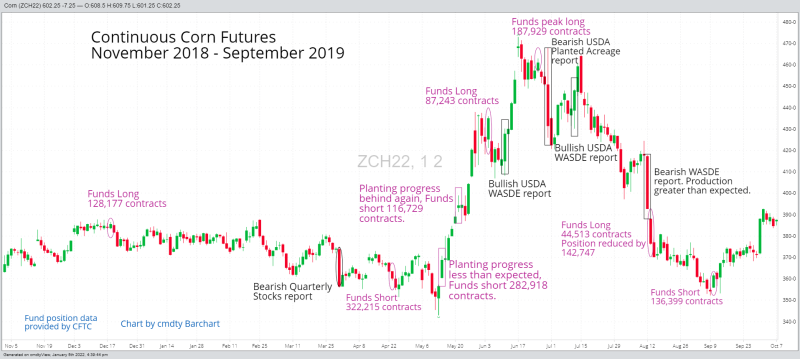There is often a misconception that the managed money commodity funds (Managed Money) tend to manipulate the markets in which they actively trade, simply to be profitable. The reality is that they trade the same fundamental and technical market information that any other market participant trades. The primary difference is that they trade more volume than most any other collective participant, which tends to overwhelm the market at times. This often leads to large and exaggerated movements in the market, as there are often few other participants that are either willing, or able, to absorb the volume with which Managed Money trades. Therefore, it becomes vital to be aware of how Managed Money is positioned, because when market sentiment changes, large market movements can happen very quickly.
Let’s look at the corn market in the spring/summer of 2019, for example. You may remember the year well. We came out of a reasonably successful 2018 growing season, which ended with rather dry areas in Missouri and Nebraska, as well as areas in the northern Midwest to a lesser degree. By the beginning of January 2019, most of the dryness had disappeared. As the winter months drew on, so did the cold and wet weather, which continued into the spring. The continued cold and wet weather not only delayed field preparation and planting, but it also caused major flooding along the Missouri and Mississippi Rivers, and their tributaries. Ultimately, what came next was a lot of volatility and market uncertainty for producers, end users, and yes, even Managed Money.

As we walk through the planting and growing season of 2019, you will be able to track many of the key points in time on the chart below. Managed Money positions and planting progress are labeled in pink, while major USDA reports are black.
By December 18, 2018, the market had rallied a little over 40 cents from the September 2018 harvest low of $3.425. With that rally, Managed Money had acquired a net long position of 128,177 contracts. With plenty of precipitation, the outlook was pretty good for a large crop to be planted, and subsequently another plentiful harvest. Added to that was a plentiful supply. The domestic carryout was well north of 2 billion bushels, and with a stocks-to-use ratio north of 15%, there was little concern about running out of corn.
Armed with bearish fundamentals, Managed Money began exiting their 128,177-contract net long position. They then began building a net short position that ultimately would become a record of 322,215 contracts by April 23, 2019. During this time, the cold, wet weather continued, along with a bearish Quarterly Grain Stocks report on March 29, which added to the negative sentiment.
Like what you’re reading?
Sign up for our free daily TFM Market Updates and stay in the know!
As the month of May rolled around, the delays were becoming more concerning and the flood damage more apparent. The planting progress numbers, released on Monday, May 13, were far below expectations. That led the market to gap open the following session and trade higher for the next month on concerns of much less planted acreage and a much smaller crop at harvest. Beginning May 14, Managed Money bought back 166,189 contracts over a five-session period and a market rally of 38 cents. They were still net short 116,729 contracts on May 21. By this time, corn prices were higher than the February high, and as the concerns grew, corn continued to trade higher. Between May 21 and June 4, Managed Money purchased 203,972 contracts, achieving a net long position of 87,243 contracts. During this time frame, corn rallied another 35 cents. Over the next three weeks, the USDA released a bullish June WASDE report, corn prices peaked at $4.73 ($1.30 from the May low of $3.43), and Managed Money reached a peak net long position of 187,929 contracts. By the June 28 USDA Planted Acreage Report, the market was expecting less corn acres planted due to wet weather. However, farmers pushed to get corn planted due to higher prices, and the acres planted exceeded expectations. Prices finished nearly limit down that day. The market volatility continued with another bullish July WASDE report, but by the end of July, market sentiment began to change, and the market had begun to trade lower. By August, the market was expecting a lower yield than the July crop report, due to perceived less-than-ideal growing conditions. However, the August WASDE report reflected a yield increase of 3.5 bushels. This bearish surprise sent the market lower to the 25-cent daily limit and down another 25 cents in the following two days. The day after the report, August 13, the Commitment of Traders report showed Managed Money still net long 44,513 contracts. This is a reduction of 142,747 contracts from their peak net long of 187,929 contracts, and a market that was 81 cents lower from the same time.
As harvest was quickly approaching, the market sentiment had fully changed from shortfall concerns to one of adequate supplies. Along with that change, the market traded to (what turned out to be) harvest lows with a Managed Money net short position of 136,399 contracts. At this point, the market had returned to the same price levels seen when the rally began back in May.
It can be debated by others whether Managed Money turned any profits during the spring and summer of 2019, and the Managed Money firms surely know the answer. There is one thing that is plainly evident as one looks back: When Managed Money decides to change direction quickly, it often takes large market swings to incentivize other participants to take the other side and let them out. Therefore, it is vital to be aware of, and take caution when, Managed Money becomes heavily positioned in either direction. Large market movements can happen very quickly.



